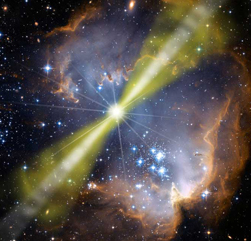New insights into gamma-ray Burst afterglows
Gamma-ray bursts are powerful bursts of gamma-ray radiation in connection with the explosive death of massive stars. The bursts themselves are short lived – lasting typically less than a few minutes, but is followed by an afterglow that can be observed for several days after the gamma-ray burst. The afterglow is thought to occur when a shockwave is emitted from the dying star and collides with the surrounding material. It is an extreme process and researchers have made theoretical models of it, but using new observations, a team including researchers from the Niels Bohr Institute, have shown that the afterglow behaves differently than expected. The results are published in scientific journal, Nature.

When a massive star dies it explodes as a supernova. The core of the star collapses into a black hole, and in care cases a jet is formed along the rotation axis of the newly formed black hole. Processes in this jet emits gamma radiation, which we observe as a so-called gamma-ray burst. Typically gamma-ray bursts last a few minutes. When the jet hits material surrounding the dying star an afterglow is formed. New observations of the degree of polarization of the afterglow light has shown that the afterglow behaves differently than expected (Illustration: NASA).
When a massive star dies, it explodes as a supernova. The core of the star collapses into a black hole. For reasons that are not yet fully understood, a jet sometimes forms which shoots away from the newly formed black hole along the star’s rotational axis at almost the speed of light. Inside the jet there are some physical processes taking places that result in the electrons being compromised, creating a strong magnetic field, and through the emission of synchrotron radiation there is a powerful burst of gamma radiation. This phenomenon is observed as gamma-ray bursts, typically lasting a few minutes. When the jet hits the surrounding matter it leads to another shockwave, which is believed to generate the afterglow.
Afterglow different than expected
Using new astronomical observations made at the Very Large Telescope, VLT, in Chile, a research team from Leicester in England and with the participation of researchers from the Niels Bohr Institute in Denmark have studied the light of the afterglow from a gamma-ray burst in the distant universe. The observations show that the afterglow behaves differently than expected.
“We have analysed the afterglow from a very bright gamma-ray burst. The gamma-ray burst took place approximately 10 billion years ago, but the signal first reached the Earth on 24 October 2012. The gamma-ray burst itself lasted just over a minute. The subsequent afterglow was relatively bright, which allowed us to study it using more advanced methods than previously possible. Specifically, it was possible to measure the degree of linear and circular polarisation during the first two days after the burst. The theory for the distribution of radiation in the afterglow predicts a particular distribution, where circularly polarised light only representing a very minimal share, but we discovered that the reality is different. There was 10.000 times more circularly polarised light than expected - actually this is the first time circular polarisation has been measured for an afterglow, explains Johan Fynbo and Jens Hjorth, professors at the Dark Cosmology Centre at the Niels Bohr Institute at the University of Copenhagen.
Extreme properties
The surrounding material that the gamma-ray burst jet shoots through and where the afterglow is created, is exposed to very extreme conditions. In a shockwave, the electrically conductive plasma interacts with strong magnetic fields in a complex dynamic. Particularly important for the afterglow is the powerful compression of the magnetic fields and it is the properties of this compressed magnetic field that determines the polarisation properties of the afterglow.
“The magnetic fields can be very ordered or they can be chaotic and very randomly oriented. The fact that we can now measure a much higher degree of circularly polarised light than the models predict show that there are holes in our understanding. This is how science works: by discovering such holes in our understanding, we are forced rethink and in this context there is hope that we can gain new insight into the properties of matter under extreme condition,” conclude Johan Fynbo and Jens Hjorth.
